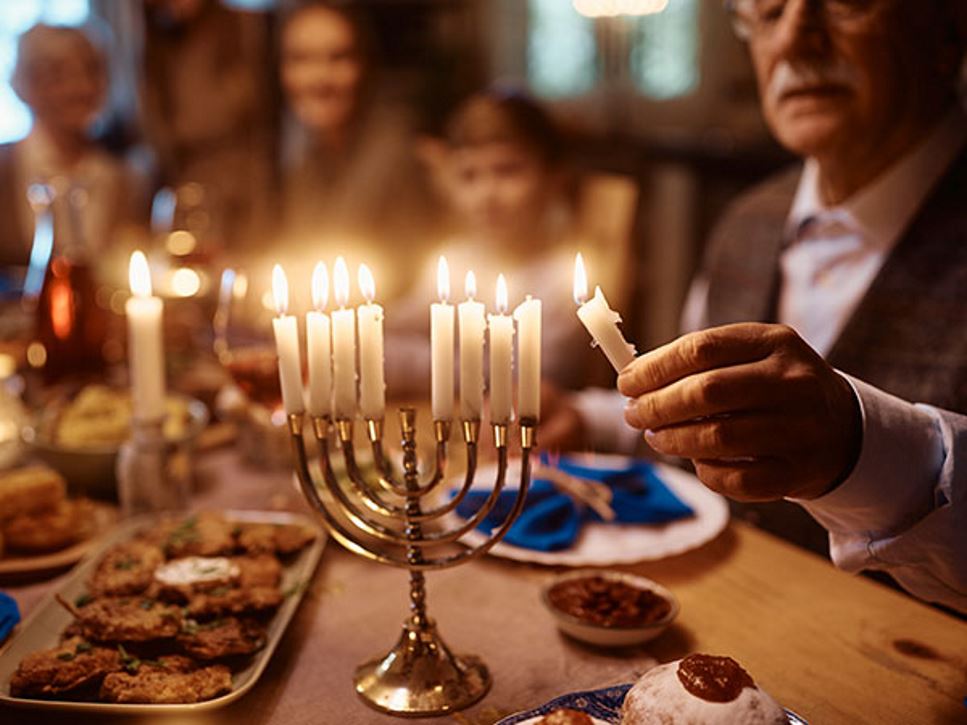A long-celebrated holiday among Jewish people, Hanukkah, or Chanukah, means “dedication” and commemorates the rededication of the Holy Temple in Jerusalem. This rededication occurred after a small group called the Maccabees defeated a Syrian-Greek army under Antiochus after fighting three years to free Jews from oppression in 164 B.C.E.
During the rededication of the Temple, there was only enough oil to burn the Menorah for one day, but miraculously the oil lasted for eight nights. In honor of this, the Hanukkah celebration lasts eight days, starting on the 25th day of Kislev on the Hebrew calendar, which occurs in December or sometimes late November.
How Hanukkah is Celebrated
Lighting the menorah: A menorah holds eight candles, plus one more called the shamash, which is used to light the other candles. On the first night, the first candle on the left is lit, and one more candle is added and lit each night. The menorah may be placed in a window to share its light with neighbors.
Gifts: Each night during Hanukkah, children may receive one gift or money called Hanukkah gelt. Gelt can also be chocolate coins wrapped in brightly colored foil with Jewish symbols.
Dreidel: A dreidel is a spinning top with four sides. The dreidel game is played with candy, pennies or chocolate coins. Players put in or receive items according to each spin. Each side of the dreidel has a letter of the alphabet, which spells out “Nes Gadol Haya Sham” or “a great miracle happened there,” referring to Israel.
Traditional Hanukkah Foods
Symbolic fried foods are prepared to commemorate the miracle of the oil, lasting for eight nights. These include:
Potato latkes (pronounced “lat-kas”), or potato pancakes, are made from shredded potatoes, eggs, onions, flour or matzo meal and salt and pepper. The ingredients are combined, then pressed thin like pancakes and fried. Traditionally, latkes are fried in goose fat; however, oil is more commonly used today. Latkes are served with sour cream or applesauce. Although less traditional, for variety, latkes can be made using other root vegetables in place of or in combination with potatoes.
Sufganiyot are donuts that are popular in Israel and the United States. They are a little smaller and wider than typical American donuts and are filled with jelly, cheese or other flavors and topped with powdered sugar. Apple fritters are another popular Hanukkah treat.
Family celebrations may include traditional Ashkenazic (Eastern European) foods for main courses, such as beef brisket, roasted chicken, kugel (noodle pudding) and challah (a braided bread). Rugelach is a favorite dessert made with a cream cheese dough and rolled with cinnamon and sugar inside. Sephardic (originally from Spain) favorites include lamb, rice and chickpeas.
Nutrition Tips
Individuals with health concerns may be watching their intake of certain nutrients more closely this time of year. Some traditional foods enjoyed at Hanukkah tend to be higher in fat, since they are fried. The sodium content also may be high if using a boxed latke mix or premade frozen latkes. Using olive oil in place of animal fats or making latkes using an air fryer or oven can reduce their saturated fat content. For individuals looking to reduce added sugars, unsweetened applesauce can be served with latkes.
Remember, it’s important to focus on the overall intake of foods and beverages throughout the year. During a holiday, consider including salads, vegetables and fruit for dessert, if these foods are lacking, to balance out meals and sweets.
Although religious and cultural observances may include foods and traditions which differ from current dietary advice, individuals can find ways to take part in these celebrations. If eating habits during a holiday are a concern to you or your family, consider speaking with a registered dietitian nutritionist. RDNs are food and nutrition experts, and they can offer healthful eating advice while still honoring food preferences and customs. This may include how to modify holiday menus or ways to enjoy foods and drinks in their traditional forms.
References
Find a Nutrition Expert
Looking for credible nutrition information and recommendations? The Academy of Nutrition and Dietetics' network of credentialed food and nutrition practitioners are ready to help!

